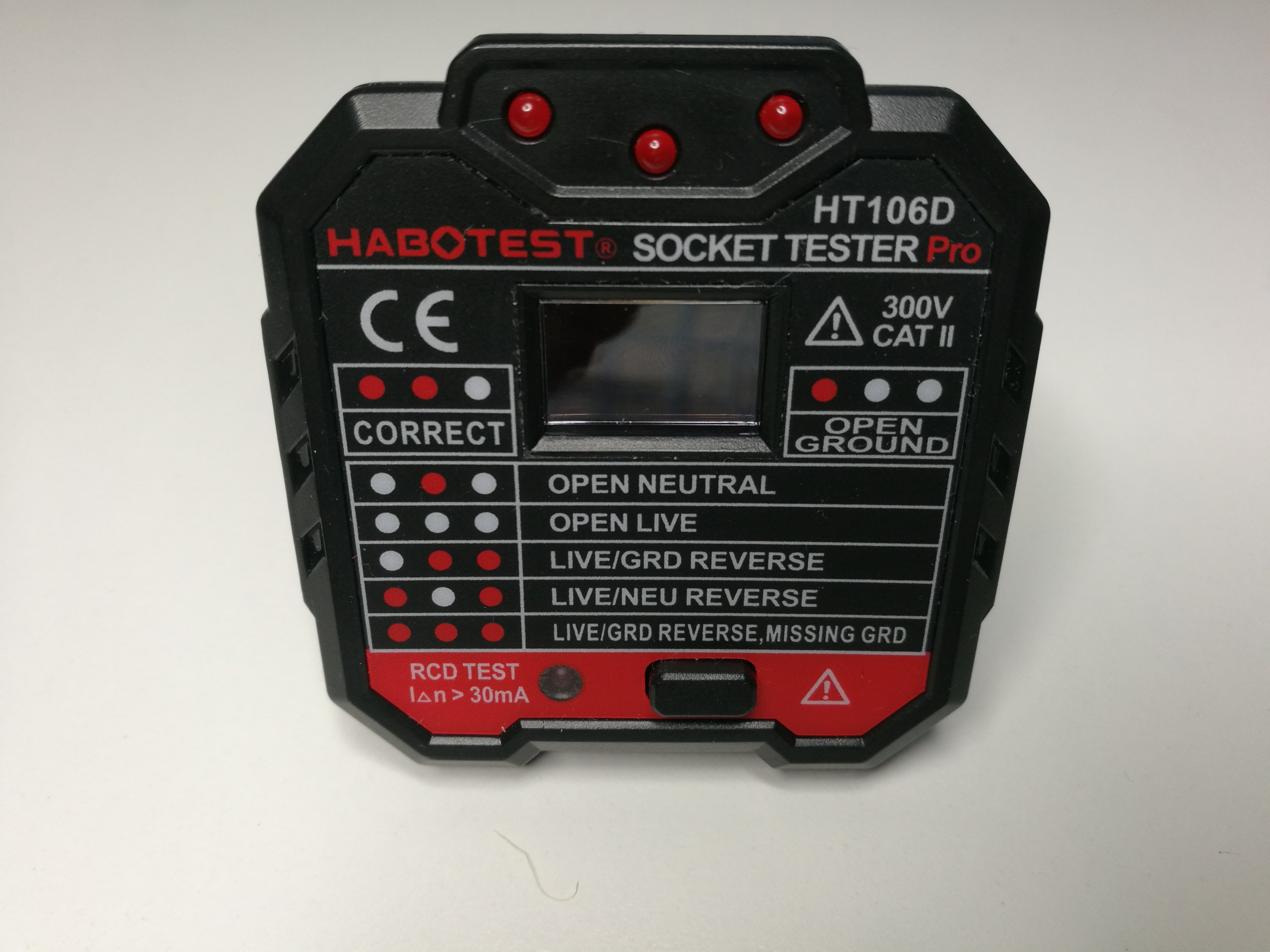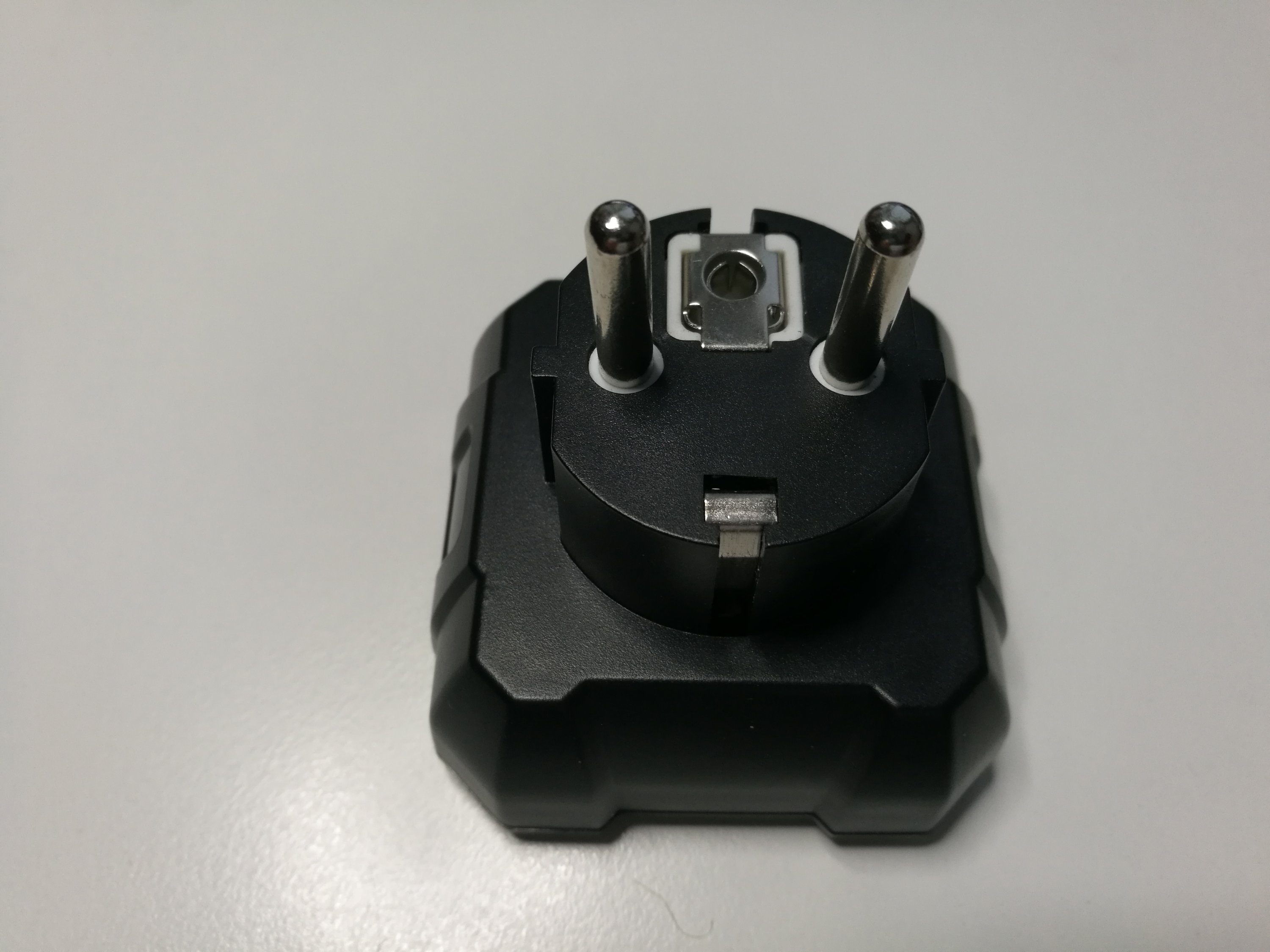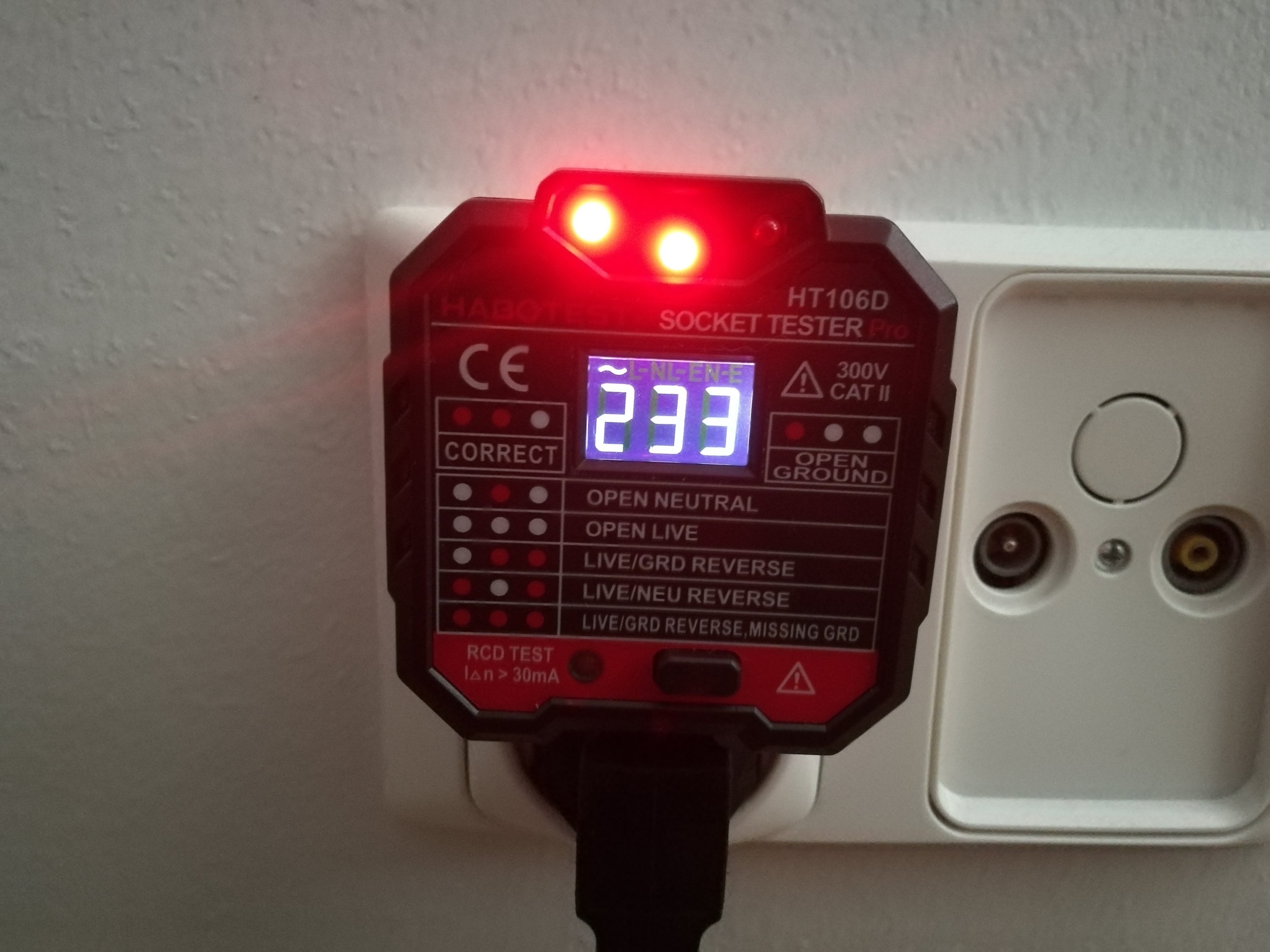An electrical outlet tester, receptacle tester or socket tester is a device used to verify that an electrical wall outlet is connected correctly. It confirms continuity and polarity of the electrical connections. The outlet tester is designed to check that each contact in the outlet is connected to the proper wire in the building’s wiring. It can identify a number of common wiring errors including phase/neutral juxtaposition and failure to connect ground. Some receptacle testers include an additional test button to check GFCI devices.
One day I saw on sale (it seems to be in sale today also) I saw an nice looking outlet tester DANIU HT106B Socket Outlet Tester Circuit Polarity Voltage Detector Wall Plug Breaker Finder RCD Test – EU plug. In addition to normal outlet tester checks and GFCI/RCD trip testing this has also a mains voltage display in it. The list price is sensible (list price ~$12) and at sale 50% off price it is cheap.

Here is the backside view of the tester with SCHUKO mains connector that works for many European countries:

When the tester is plugged to wall, the LEDs will show wiring correctness and LCD numeric display shows the mains voltage.

The mains voltage display was pretty accurate, within around one percent compared to multi-meter reading I had. The voltage meter seemed to show voltage reading from around 30V to 270V – so the measurement range was even slightly bigger that promised (at lower than 48V voltage the display was quite dim).
The RCD tester send the trip current by connecting around 6.4 kohm resistor from live wire to ground. For this test to work, the tester needs to be plugged to mains outlet in the correct ways – means that to test RCD, first check that the wiring testing LEDs are show correct wiring.
On my quick tests, this mains outlet tester worked well according to the what the manufacturer has promised. It was well worth of the prove paid. Mechanical construction felt also good.
Some videos of similar testers tested (quite possibly same product with just other brand printed on the case):
Taiss TA106B socket tester pro
Socket Tester. Full Review.
8 Comments
Tomi Engdahl says:
SDG Mailbag #035 Testing a Cheap AC Socket Wiring Tester (Use with caution…)
https://www.youtube.com/watch?v=a6pZ_eiGu6o
Tomi Engdahl says:
Taiss TA106B socket tester pro
https://www.youtube.com/watch?v=vmoYUm8Jkik
Tomi Engdahl says:
Does this have this minor leakage problem also?
Why Fluke are recalling their SM100/200/300 plug-in testers.
https://www.youtube.com/watch?v=_KOYt-0WZxg
Fluke are recalling their plug-in socket testers and offering exchange products. There’s nothing actually wrong with the testers other than the modest current used to power the test indicators that can cause a strong sensation when a ground path is open circuit and someone bridges it during the test. (mild shock risk)
The recall is more an indication of the increasingly litigious nature of society and the current trend of deskilling the electrical industry
https://www.fluke.com/en-gb/support/safety-notices
Tomi Engdahl says:
If the Socket Tester detects a missing earth condition, shown on the tester as ●○○, the internal circuitry will source a voltage from the phase conductor onto the earth pin of the socket outlet, as well as any metal parts connected to the earth pin of the socket.
Such a condition can result in an electric shock to the user. The current level is probably not life threatening in most cases but could be painful and may be sufficient to knock a person down or off a ladder.
https://www.fluke.com/en-gb/support/safety-notices/fluke-sm100-sm200-and-sm300-electrical-socket-testers-voluntary-recall
Tomi Engdahl says:
Good versus evil socket testers. (with schematics)
https://www.youtube.com/watch?v=3_3FCAbNyMM
One of these socket testers is great and one has been over-engineered with lots of extra weaknesses as a result. In hindsight I’m wondering if the hot resistors (110C) were masking the transistor or if the transistor itself was getting that hot. If it is dissipating about quarter of a watt then it should be within its capability.
Tomi Engdahl says:
Inside a mains socket tester with LCD display. (with schematic)
https://www.youtube.com/watch?v=-xm4l13aY6I
I was sent this socket tester by Adrian, who had been disappointed that the LCD display was not the information display that was implied in some of the eBay listings.
The LCD display is very simple, but it does provide a very functional test for dangerous voltage potentials with respect to the building’s earth/ground circuit. That’s rare, but a polarity test is an important part of the test of an electrical installation. This plug is simple, but very functional. It’s not as glamorous or sophisticated as the “Socket & See” tester with its automatic loop impedance check (the resistance of the entire live/earth loop to the utility transformer) but it’s a fraction of the price.
Tomi Engdahl says:
Mapping Out The LEDs On An Outlet Tester
https://hackaday.com/2022/08/09/mapping-out-the-leds-on-an-outlet-tester/
The concept of an outlet tester is pretty simple: plug the gadget into a suspect wall receptacle, and an array of LEDs light up in various patterns to alert the user to any wiring faults. They’re cheap, reliable, and instantaneous. Most people wouldn’t give them much more thought than that, but like any good hacker, [Yeo Kheng Meng] wanted to know how these devices worked.
After picking up a relatively advanced model that featured an LCD display capable of showing various stats such as detected voltage in addition to the standard trio of LEDs, he started by using some test leads to simulate various fault conditions to understand the basic principle behind its operation. The next step was to disassemble the unit, which is where things went briefly sideways — it wasn’t until [Yeo Kheng Meng] and a friend had nearly cut through the enclosure that they realized it wasn’t ultrasonically welded liked they assumed, and that the screws holding it together were actually hidden under a sticker. Oops.
The write-up includes some excellent PCB shots, and [Yeo Kheng Meng] was able to identify several components and ascertain their function.
Teardown of Habotest HT107E Socket Tester
https://yeokhengmeng.com/2022/08/teardown-of-habotest-ht107e-socket-tester/
https://github.com/yeokm1/ht107e-socket-tester-teardown
Tomi Engdahl says:
Habotest HT107D/E – socket tester
https://www.tnt-audio.com/accessories/habotest_ht107d_e.html
There are many different socket testers in the market, some are very basic and just tell you whether the cables are connected in the right way or not, but we audiophiles need more, as usual. I’ve choosen this Habotest HT107D socket tester, which is labelled as “Pro”, whatever this might imply. Habotest is a Chinese company, located in Dongguan, which manufactures many different testers, so it is reassuring to know this is their sole business. They do not manufacture other electronic components, just testers. They also manufacture different socket testers. The one I’ve decided to test is the model HT107D which is the most complete of the catalogue
what’s going on/wrong. Theorically, the voltage between neutral and earth (N-E) should be 0 Volts, but in real life conditions it is considered acceptable if it stays below 10V. The lower the better, of course. This highly depends on the mains distribution system,
By measuring live-neutral voltage, neutral-ground voltage and live-ground voltage you are ready to answering these questions:
Is the outlet wired incorrectly?
Is the branch circuit too heavily loaded?
Do sensitive electronic components have the voltage they need to work (sound!) properly?
Conclusion
This Habotest HT107D is quite a useful device and lets you understand easily what’s going on, even if you’re not a trained technician. Just insert it into the socket you wish to test and you’re done! It makes no use of batteries and is 100% safe to handle. Another must-have, I’d say.